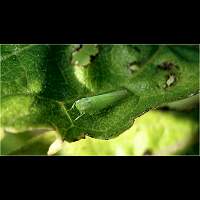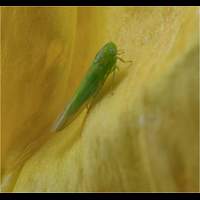Empoasca species
There are quite a few Empoasca species. Most are greenish and very small indeed, usually reaching a length of some 1 to 4mm. They are found around the world and it is almost impossible to identify the separate species without examining them under the microscope. We haven't done that to the animal depicted on this page, so we have no idea which of the five species living in this country it is. Most Empoasca species spend just about their entire life on the underside of the leaves of the foodplant. They are long lived, for they overwinter being adult. The larvae are green too and great hoppers, capable of jumping forwards, backwards and sidewards.
Various Empoasca species are causing damage in agriculture. Empoasca solani for instance can cause quite some damage on sugar beets. Empoasca vitis is found on grapes and apples. Other plants may suffer from other Empoasca species. Damage varies from plant species to plant species. The symptoms are worse in sugarbeets, where the top of the leaves turns brown and then dies. The disease is called Hopperburn and the symptoms are often similar to those caused by viruses or malnutrition. Because of their small size this cicade is often referred to as one of the greenfly, a group of fly-like Aphids, but it is not a fly, nor an Aphid.
There are quite a few Empoasca species. Most are greenish and very small indeed, usually reaching a length of some 1 to 4mm. They are found around the world and it is almost impossible to identify the separate species without examining them under the microscope. We haven't done that to the animal depicted on this page, so we have no idea which of the five species living in this country it is. Most Empoasca species spend just about their entire life on the underside of the leaves of the foodplant. They are long lived, for they overwinter being adult. The larvae are green too and great hoppers, capable of jumping forwards, backwards and sidewards.
Various Empoasca species are causing damage in agriculture. Empoasca solani for instance can cause quite some damage on sugar beets. Empoasca vitis is found on grapes and apples. Other plants may suffer from other Empoasca species. Damage varies from plant species to plant species. The symptoms are worse in sugarbeets, where the top of the leaves turns brown and then dies. The disease is called Hopperburn and the symptoms are often similar to those caused by viruses or malnutrition. Because of their small size this cicade is often referred to as one of the greenfly, a group of fly-like Aphids, but it is not a fly, nor an Aphid.





